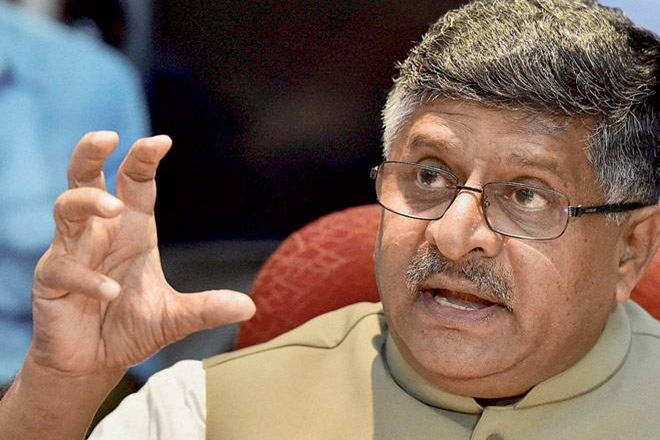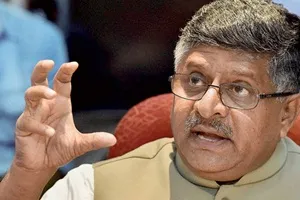
 Telecom minister Ravi Shankar Prasad may have got the telecom industry up in arms over his campaign against call drops, but he has also worked hard to address the industry’s biggest constraint, that of shortage of spectrum – Prasad has also gone out of his way to dismiss fears of harmful radiation from telecom towers, though it is not clear whether his statements on allowing more towers on government buildings will result in this bottleneck getting addressed. While the groundwork for releasing 3 carriers of 5MHz each in the 2100MHz frequency band was done by the UPA, the agreement with the defence ministry got stuck somewhere in between – that is why, to the surprise of most, this additional spectrum was not put on offer in the 2015 auctions which, in turn, is what led to a desperate scramble for spectrum and the resultant high bids. With the defence ministry’s doubts put to rest, this spectrum will now be available in the July auctions.
Telecom minister Ravi Shankar Prasad may have got the telecom industry up in arms over his campaign against call drops, but he has also worked hard to address the industry’s biggest constraint, that of shortage of spectrum – Prasad has also gone out of his way to dismiss fears of harmful radiation from telecom towers, though it is not clear whether his statements on allowing more towers on government buildings will result in this bottleneck getting addressed. While the groundwork for releasing 3 carriers of 5MHz each in the 2100MHz frequency band was done by the UPA, the agreement with the defence ministry got stuck somewhere in between – that is why, to the surprise of most, this additional spectrum was not put on offer in the 2015 auctions which, in turn, is what led to a desperate scramble for spectrum and the resultant high bids. With the defence ministry’s doubts put to rest, this spectrum will now be available in the July auctions.
The moves to allow spectrum trading and sharing have been equally critical since, while top telecom companies are keen to take on the spectrum that others have, they do not wish to take on the large quantities of debt that go along with this. Sharing/trading, on the other hand, allow debt-ridden telcos – or those with very few subscribers – to hand over the spectrum without the debt; the proceeds they get can then be utilized to retire debt. While there are still a few deals to be struck – Telenor still has 5mhZ of 1800MHz spectrum in six circles that is up for sale – some big deals already done are those of RCom and RJio and Bharti Airtel with Videocon and Aircell. Immediately, in the case of Bharti Airtel, it has managed to stitch together a pan-India 4G network that gives it a first-mover advantage over RJio whose USP is supposed to be its data offering.




As reported by FE on Tuesday, by June 15, telecom companies will have completed the harmonization of their spectrum. Right now, the defence ministry is to get 20MHz of the 75MHz in the 1800MHz band, but this spectrum – along with that of the private telcos – is scattered across the band. For the spectrum to be more useful, especially for data services, the spectrum should be contiguous and at least be 5Mhz in size. Vodafone, for instance, has two chunks of 3.4MHz and 4.4MHz of 1800MHz spectrum in Gujarat, but cannot use them for data as they are not contiguous. But now, with the defence ministry and private telcos temporarily surrendering their spectrum, each will get spectrum that is contiguous. While Vodafone will be able to offer 4G services in another 3-4 circles using the spectrum it already has, Idea has paid for spectrum in 4 circles but was not allocated this across the full area – with harmonization, it will now get the spectrum in the full circle in the case of Haryana, Maharashtra, Punjab and the north east. More important, from the government’s point of view, the move will throw up another 7MHz of contiguous spectrum across the country which, at even the base price, will fetch it another Rs 20,000 crore.
Prasad would do well to now work on the way the Trai is setting prices for auctions. If setting the last auction bid as the reserve price for the next auction is not bad enough, as this newspaper has pointed out, the pricing of 700MHz is completely illogical (url of what’s trai playing at?). Though less ridiculous, reserve prices are too high and illogical in other frequencies as well. In the 2010 auction, for instance, Delhi and Mumbai accounted for 14.5% of the revenue across the country but the reserve price for spectrum was 40% of that for the entire country. Since Trai still continues with irrational pricing, Prasad would do well to have a detailed study of this and its impact – since the 700MHz auction is certain to fail and the Cabinet will have to take a call on reducing the reserve price, this exercise will be critical.


















